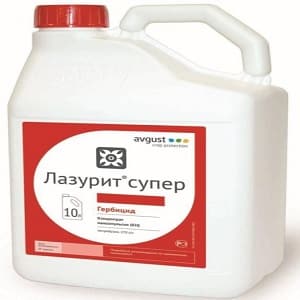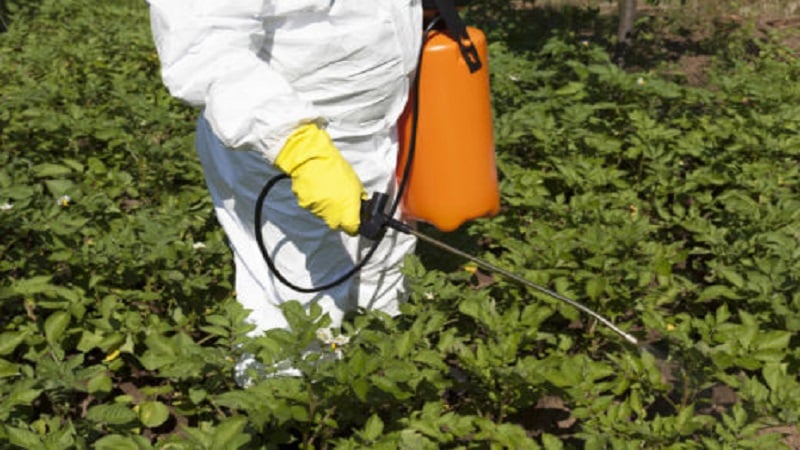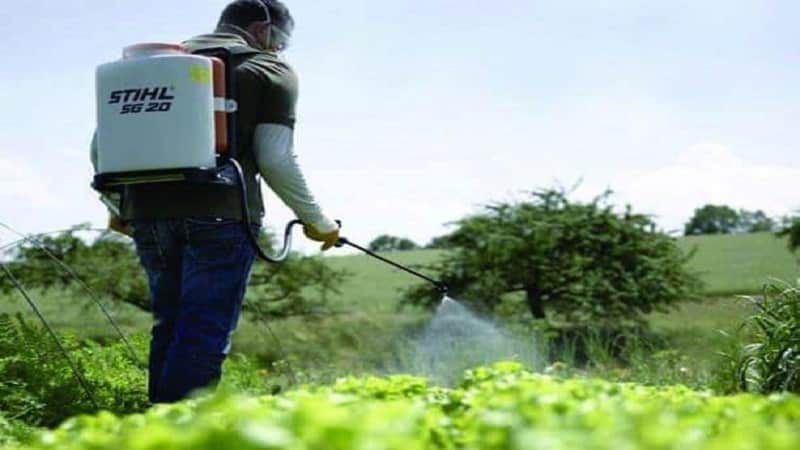How to get rid of weeds on potatoes using Lazurit or its analogues
To get a rich potato harvest, it is necessary to constantly fight weeds. These plants not only take away nutrients and moisture, but also cause diseases, pest invasions, damage to the marketable appearance and reduced yields. To protect their beds, farmers use herbicides.
Read about the principle of action, effectiveness, rules of use, reviews and analogues of “Lazurite” for weeds on potatoes in our article.
Description, characteristics and features of the drug
The drug "Lazurit" is a universal remedy with a selective effect on weeds. It is used in the fight against unwanted vegetation in potato and tomato beds.
When deciding to use herbicides, each farmer takes into account the number of weeds on the site.

The herbicide is used to control 50 types of weeds. The most common of them:
- quinoa;
- ambrosia;
- thistle;
- amaranth;
- pigweed.
Operating principle
The effectiveness of the drug is based on the content of the active substance metribuzin. 1 kg of solution contains 700 g of this substance. This concentration is detrimental to plants and soil, so Lapis Lazuli is diluted.
As soon as the drug hits the weed plant, it penetrates inside. The product is well absorbed into the stems and leaves, and when watered, it affects the roots. Metribuzin suppresses photosynthesis, interferes with the absorption of moisture, nutrients and oxygen, which is why the weed dies.
The effect of the drug begins immediately after its use. The weeds will begin to dry out within a week and will completely disappear from the area two weeks after treatment.
Advantages
The drug does not accumulate in the plant and soil, therefore considered safe for humans and animals. Also, “Lapis Lazuli” does not interfere with the taste, growth and development of the crop, so the yield does not fall.
Main advantages:
- high permeability inside the plant;
- impact on annual and cereal weeds;
- long period of exposure;
- ease of preparation and use of the solution;
- effective against 50 different plant species;
- low cost - about 100 rubles. for 20 years
Manufacturers claim that the drug not only protects against weeds, but also develops potato resistance to cold weather and late blight.
How to dilute the product
Depending on the degree of weed growth in the previous season the farmer decides how many times to apply the treatment in the new one.
With a small number of weeds, it is enough to carry out one procedure - dilute 10 g of Lazurite in 3 liters of water. The treatment is carried out by spraying until the potatoes emerge. The consumption of the working solution is 3 liters per 100 m².
If weed rhizomes grow rapidly, you will need to do two procedures. The second treatment is carried out when the sprouts reach a height of 5 cm. Use a working solution - 10 g per 9 liters of water. Liquid consumption - 9 liters per 300 m².
Important! During processing other cultures the concentration of the drug is changed.
Rules for diluting the drug:
 1/5 of the liquid volume is poured into the spray tank.
1/5 of the liquid volume is poured into the spray tank.- The herbicide is added.
- The solution is thoroughly stirred until the powder is completely dissolved.
- Then add water to the volume specified in the instructions.
"Lapis lazuli" is always stirred in a large amount of water.
When diluting the solution, take into account:
- plot size;
- soil condition;
- number of weeds.
After processing unused solution is disposed of. The drug in a diluted state quickly loses its properties, so it cannot be stored.
Interesting things on the site:
Instructions for use
Experienced farmers are often proactive when it comes to weed control. - treatment is carried out even before the weeds emerge. To prevent the crops from being damaged by the drug, it is important to deepen them.
Optimal temperature conditions for processing with Lapis Lazuli are +17…+24°С. Before the procedure, it is important to make sure that no precipitation is expected that day. Rain helps the product penetrate into the soil, where it loses its effectiveness. During the dry period, the activity of the active substance of the drug decreases.
First use
Before the first spraying, the soil is loosened and moistened. Then wait until the soil settles a little. Processing is carried out in dry, windless weather.
Per 1 m² of plot, the concentration of the drug is 1-1.5 kg. If weeds have already appeared, the solution is poured directly under the root of the plant or sprayed from a spray bottle.
The validity period of Lazurit depends on weather conditions. In good warm weather, the drug is effective for two months after treatment.
Important! The first treatment is carried out as soon as the air temperature warms up to +15°C.
After the procedure, you should not turn over the clod of earth.. Digging up the area will result in the drug getting onto the buried potato tubers.
Treatment of sprouted weeds
If the first treatment was ineffective, the herbicide is used as soon as the seedlings reach a height of 5 cm. The concentration of the drug is reduced - 400 g is enough for 1 m².
Processing potatoes with Lapis Lazuli
To treat potato crops, the concentration of the solution is used - 2.5 l per 1 m². 20 g of Lazurit are diluted in 20 liters of water. The maximum concentration of metribuzin should not exceed 0.5%.
Important! The drug is suitable for all varieties of potatoes, except early ripening ones.
When early potatoes need processing, use 0.5 kg of Lazurit, for late varieties - 1.5 kg of the drug.

Factors affecting herbicide consumption:
- Soil fertility. In heavy soil the dose of the drug is maximum, in light soil it is minimum.
- Peat and humus content. If the site is located on peat soil or with a humus content of up to 6%, treatment is carried out after the appearance of weeds.
- Cultivar variety. When processing early potato varieties, the herbicide concentration is minimal.
Safety precautions for use
The drug only works on weeds. Vegetables treated with Lazurit do not pose a danger to people and animals. To prevent the chemical from damaging the potato tubers, they are deepened by 15-20 cm.
The herbicide has been assigned the third hazard class — harm to health can be caused during processing of beds.
Security measures:
- the procedure is not carried out if the wind speed reaches 5 m/s;
- It is prohibited to prepare the working solution in food containers;
- processing is carried out in protective equipment - mask, goggles, gloves, gown;
- Do not eat, drink or smoke while working with the drug;
- after the procedure, you need to take a shower, wash your work clothes and wash the spray bottle;
- It is prohibited to stay in the treated area for more than four hours.
The herbicide is low-risk for pollinating insects. But in order to avoid poisoning of bees, it is recommended to carry out treatment 2-3 km from the hives. The drug is prohibited to be used in the water protection fishery zone.
What drugs is it compatible with?
To save product consumption and increase efficiency, the herbicide is combined with other drugs. In addition, Lapis Lazuli is not a fertilizer. If there is an imbalance of nutrients in the soil, even if there are no weeds, the harvest will not be abundant.
Important! When mixing drugs, the solution must be homogeneous.
"Lapis lazuli" combined with insecticides, pesticides, fungicides, nematicides and acaricides.
In what cases should it not be used?
The drug, despite its wide spectrum of action, It is not recommended to use:
- on sandy soil;
- if the crop has suffered a disease;
- during sudden temperature changes;
- during drought;
- for processing early varieties;
- with a small number of weeds;
- if plants react poorly to herbicides.

What should be the result after using Lazurit?
After using the drug, the weeds will begin to dry out within a week., for complete disappearance from the site it will take from 14 to 30 days. If the result is not achieved, an error may have been made in working with the herbicide.
Factors to consider:
- processing time;
- drug concentration;
- dosage for a single or repeated procedure;
- waiting time for the herbicide to take effect;
- security measures;
- weather.
The diluted drug cannot be stored. The solution is used within 24 hours. The shelf life of the sealed herbicide is 5 years.
Analogs of "Lazurit"
Lapis lazuli is not the only herbicide used in weed control.
They have similar properties:
- "Titus";
- "Herbitox";
- "Zenkor";
- "Anti-sap";
- "Metrizan";
- "Gardener".
Read also:
Reviews about the product
Gardeners leave mostly positive reviews about Lazurit. They note the availability, effectiveness and safety of the drug.
Marina, Krasnodar: “I used to fight weeds in the traditional way - weeding. After expanding the site, I tried Lapis Lazuli. A few days after the first spraying, all the excess grass had dried up. The procedure was repeated when new weed shoots were seen. After that, there was only one potato left in my beds. Satisfied with the herbicide".
Dmitry, Novokubansk: “I have large potato fields, so ordinary weeding cannot save the crop. A few years ago I tried Lapis Lazuli and was not disappointed. Now I only trust this product; I have never once had a herbicide spoil the quality of the crop. The drug kills weeds well and has a long-lasting effect.".
Gennady, Borovichi: “I use organic technologies on my plot, but when the weeds take over, I switch to herbicides. “Lazurit” is the most effective - it is low-toxic, inexpensive, applied in minimal doses and does not inhibit potatoes. I start processing even before the crop sprouts. One procedure is enough for me".
Conclusion
“Lapis lazuli” is a universal remedy that is effective even against actively growing weeds. It is not only harmless to potatoes, but also makes them more resistant to frost and late blight.
Most farmers speak well of the product: it is effective, accessible and inexpensive.It is used both in fields and in small areas - the main thing is to correctly calculate the dosage. “Lapis lazuli” is also combined with other drugs. Complex treatments will protect against diseases and increase potato yield.
Hello, I have 2 questions on different sites, they write differently about 5 cm, on one they write that it is necessary to spray a second time while the sprouts are up to 5 cm, on the other until they reach 5 cm, so after all, the code is better and safer, those who say that up to 5 cm argue for this the fact that young people tolerate it more easily and the second question is how to understand 1 kg per 1 square meter and 400 grams per 1 square meter if in the instructions and you yourself write that 3 liters per 100 square meters solution consumption, well, it can’t be 100 in 3 liters or 40 kg please explain
and they themselves don’t know shit